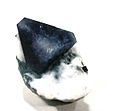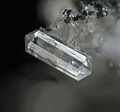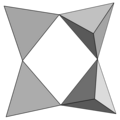Ring silicates
When Ring silicates (silicates cyclo) is referred to silicates , the silicate anions of rings of corner-sharing SiO 4 consist tetrahedra. The rings are isolated; H. they are not linked to one another via further Si-O bonds to form layers or frameworks.
This department of silicates includes important groups of rock-forming minerals such as B. the tourmaline group and gemstones such as beryl or benitoite .
The number of silica tetrahedra in the rings is often reflected in the symmetry of the crystals. Three and six-ring silicates are often trigonal or hexagonal, four-ring silicates are often tetragonal or orthorhombic.
classification
Silicate classification according to Liebau
In Liebau's structural silicate classification, ring silicates, as well as island silicates and group silicates, belong to the silicates with dimensionality 0. The extent of the silicate anions is not unlimited in any direction (0 dimensions).
Liebau divides the ring silicates based on the structure of the silicate groups according to the following criteria:
Counting:
It indicates how many silicate tetrahedra the rings are made of. Only the SiO 2 tetrahedra that are required to close the ring are counted . Other tetrahedra that are linked to the ring (branches) are not counted. The number of natural ring silicates is usually 3 to 6. The largest so far found silicate ring of a mineral has a number of 18 ( megacyclite ).
Triple ring of the benitoit
4-ring of the papagoite
6 single ring of beryl
9 single ring of the eudialyte
18 single ring of the Megacyclit
Multiplicity:
It indicates how many rings are linked to form multiple rings. So far no ring silicates with a multiplicity > 2 are known.
Branching:
It indicates whether further SiO 4 tetrahedra branch off from the silicate ring . A distinction is made between openly branched silicates and cyclically branched silicates, in which the SiO 4 tetrahedra branching off the chain form closed rings.
Openly branched 6-ring of tienshanite
Mixed silicate anions:
Some ring silicates contain other isolated silicate anions in addition to the silicate ring. Diversilit- (Ce) e.g. In addition to a silicate three ring B. contains a SiO 3 OH island silicate group , Strakhovit a four-ring and a Si 2 O 7 - Gruppensilikatanion .
Strunz
The 9th edition of the Strunz mineralogical tables is based on the silicate classification by F. Liebau and divides the ring silicates division (09 C) primarily according to the size of the rings (number), then according to the ring multiplicity and branching and finally according to the occurrence of others isolated anion complexes.
- 9.CA [Si 3 O 9 ] 6− triple single rings without island-like, complex anions
- 9.CB [Si 3 O 9 ] 6− triple single rings with island-like, complex anions
- 9.CD [Si 3 O 9 ] 6− triple double rings
- 9.CE [Si 4 O 12 ] 8− four-single rings without island-like, complex anions
- 9.CF [Si 4 O 12 ] 8− four-single rings with island-like, complex anions
- 9.CG [Si 4 O 12 ] 8− Branched four-single rings
- 9.CH [Si 4 O 12 ] 8− four-double rings
- 9.CJ [Si 6 O 18 ] 12− Six-single rings without island-like, complex anions
- 9.CK [Si 6 O 18 ] 12− Six single rings with island-like, complex anions
- 9.CL [Si 6 O 18 ] 12− Branched six-single rings
- 9.CM [Si 6 O 18 ] 12− six double rings
- 9.CN [Si 8 O 24 ] 16- figure eight rings
- 9.CO [Si 9 O 27 ] 18− nine rings
- 9.CP Twelve and larger rings
Dana
The systematics of minerals according to Dana , which is predominantly used in English-speaking countries , also classifies the ring silicates first according to the size of the rings and then according to the appearance of further isolated anion complexes.
- 59. Ring silicates (cyclosilicates) with rings of three
- 60. Ring silicates with rings of four
- 61. Ring silicates with six rings
- 62. Ring silicates with figure eight rings
- 63. Ring silicates with condensed rings
- 64. Ring silicates: rings with other anions and insular silicate groups
See also
Individual evidence
- ↑ a b c d e f g Liebau 1982
- ↑ a b c d Mineral class 9th C according to Strunz 9th edition
- ↑ a b c d Nickel-Strunz Silicates Classification (Version 10)
- ↑ a b c d Nickel-Strunz Classification - Cyclosilicates 10th edition
- ↑ University of Tübingen: Systematics of Minerals - Cyclosilicates (ring silicates)
Web links
- webmineral: Nickel-Strunz Silicates Classification (Version 10)
- mineralienatlas: Mineral class 9.C according to Strunz 9th edition - ring silicates (cyclosilicates)
- mindat.org: Nickel-Strunz Classification - Cyclosilicates 10th edition
- University of Tübingen: Systematics of the minerals
literature
- F. Liebau (1982): Classification of Silicates in: Reviews in Mineralogy Volume 5: Orthosilicates; Mineralogical Society of America

















